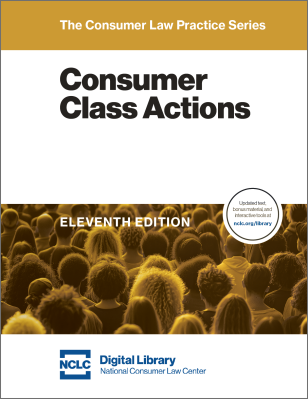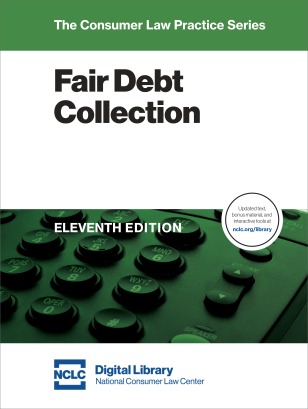The Supreme Court’s decision in TransUnion L.L.C. v. Ramirez, 141 S. Ct. 2190 (2021), creates serious constitutional standing obstacles for consumer litigation in federal court, particularly for class actions and claims seeking statutory damages. As explained in another NCLC article, Ramirez held that a credit reporting agency’s false identification of class members as terrorists did not cause them a concrete injury where that false information had not yet been reported to third parties, so they did not have standing to bring an FCRA claim for statutory damages. The Supreme Court’s 2016 decision in Spokeo, Inc. v. Robins, 136 S. Ct. 1540 (2016), laid the groundwork for Ramirez’s rejection of most of the grounds on which the class members claimed standing.
In almost every consumer case brought in federal court involving statutory damages, intangible injuries, or a class action, practitioners can expect that defendants will raise Ramirez and constitutional standing questions. For analysis of recent federal caselaw interpreting Ramirez as it applies to federal consumer claims, see these NCLC treatises:
- Fair Debt Collection § 11.15 (FDCPA);
- Fair Credit Reporting § 11.3 (FCRA);
- Federal Deception Law § 7.4 (TCPA);
- Consumer Class Actions § 10.3.2 (class action issues).
Because of the obstacles Ramirez creates for federal court litigation, filing these cases in state court is an attractive alternative. If a case is filed in state court, the defendant will often have the right to remove it to federal court, but if the federal court lacks jurisdiction because of Article III standing, it will remand the case back to state court. The case can then be litigated in state court—if the state court’s standing rules are less restrictive than Ramirez.
This article explains why state courts are not bound by Ramirez and should not import its holdings into their own standing doctrines. Of special utility to practitioners is a new NCLC state-by-state analysis of state court standing rules as they apply to consumer claims, which for a limited time is free to the public.
Why Ramirez Does Not Limit State Court Standing to Bring Claims under Federal Consumer Protection Statutes
Article III, § 2 of the U.S. Constitution limits federal court jurisdiction to cases and controversies. But the Supreme Court has held “the constraints of Article III do not apply to state courts, and accordingly the state courts are not bound by the limitations of a case or controversy or other federal rules of justiciability even when they address issues of federal law, as when they are called upon to interpret the Constitution or, in this case, a federal statute.” ASARCO Inc. v. Kadish, 490 U.S. 605, 617 (1989).
Moreover, if a state opens its courts to state claims, it must also do so for analogous federal claims. See Haywood v. Drown, 556 U.S. 729 (2009). Accordingly, if a state’s courts accept jurisdiction over private state statutory causes of action, they must do so for private causes of action created by federal statutes.
NCLC’s State-by-State Analysis of State Court Standing Requirements Is Now a Critical Resource
In this new climate, understanding each state’s own standing rules is critically important—to evaluate both whether a particular state’s courts are likely to accept jurisdiction over a claim under federal consumer protection laws and, of course, whether standing will be an obstacle to hearing claims based on state consumer laws. To assist in that analysis, NCLC has produced a 50-state, state-by-state analysis of state standing law, focusing on whether the state supreme court requires a showing of a concrete injury, whether its general test for standing differs from the U.S. Supreme Court’s, and whether it treats legislative creation of a right and a cause of action to enforce it as satisfying the state’s standing requirements.
NCLC gratefully acknowledges the many practitioners who contributed to the analysis, and the nationally recognized class action firm Berger Montague, which made an excellent 2015 summary of state standing doctrines available to NCLC for purposes of preparing the appendix.
Because state standing rules as applied to consumer statutes may still be unsettled or opaque in some states, NCLC particularly welcomes comments, corrections, and additions to the state-by-state analysis, sent to [email protected]. For a limited time, the state-by-state analysis is free to the public. See NCLC’s Consumer Class Actions Appx. G.
Most State Supreme Courts Have Not Endorsed Ramirez or Spokeo
Whether state courts should follow Spokeo and Ramirez is an open question in almost all fifty states and the District of Columbia. Ramirez was issued nine months ago, yet the only state Supreme Court decision to cite it with approval as of early 2022 is State ex rel. W. Va. University Hospitals-East, Inc. v. Hammer, 866 S.E.2d 187, 196 (W. Va. 2021). Similarly, barely a handful of state supreme courts have cited Spokeo with approval for anything other than general principles. A substantial number of state supreme courts have rejected Lujan v. Defenders of Wildlife, 504 U.S. 555 (1992), the seminal decision setting forth the Supreme Court’s general test for standing, including the concrete injury requirement that Ramirez construed so harshly. See NCLC’s Consumer Class Actions Appx. G.3.1.
Moreover, most state supreme courts have never ruled on state court standing requirements as specifically applied to consumer protection statutes. Instead, in many states, the standing doctrine has developed in cases where the legislature did not create a private right of action, such as taxpayer suits or citizen suits challenging governmental policies or expenditures.
Why State Courts Should Not Follow Spokeo and Ramirez
The basis for state courts’ standing doctrines varies greatly from state to state. In many states, the state constitution does not limit the state courts’ jurisdiction to cases and controversies. Courts in these states may conclude that there is no reason to give any weight to U.S. Supreme Court standing decisions, since they are based on a cases or controversies clause that does not appear in the state constitution. See NCLC’s Consumer Class Actions Appx. G.4. Another reason not to follow federal rules on standing is that federal courts are courts of limited jurisdiction, while the main trial court in a state is typically a court of general jurisdiction, created to exercise expansive jurisdiction.
States whose constitutions do not have a cases or controversies clause may base their standing rules on principles of separation of powers—that the legislature and courts have separate functions. See NCLC’s Consumer Class Actions Appx. G.4. In these states, there are strong arguments that separation of powers concerns mean that courts should recognize and implement a cause of action created by the legislature. Doing so gives respect to the legislature’s role in government; to close the courts to suits to enforce a right created by the legislature disrespects and intrudes upon the role of the legislature to make laws. See NCLC’s Consumer Class Actions Appx. G.3.2.
In other states, the standing doctrine is not based on any state constitutional provision, but is judge-made and based on prudence, judicial policy, and common law. See Appx. G.4. In these states, courts should apply and enforce consumer protection laws that give consumers who have experienced a violation a right to bring suit. To decline to do so contrary to explicit legislation goes beyond judicial restraint, and instead disregards the courts’ proper role and intrudes into the legislative sphere.
Many state supreme court decisions articulate the principle that standing exists if a specific statute grants the litigant a right and a cause of action to enforce it. In many states, state supreme court decisions make it clear that this is an alternate, independent path to standing, and the litigant need only meet the requirements set forth in the statutory cause of action, not the state’s usual standing rules. See NCLC’s Consumer Class Actions Appx. G.4. While most state supreme courts articulating this principle have not yet applied it to suits under consumer protection statutes, it provides a strong starting point for an argument that standing exists whenever a consumer meets the requirements for a cause of action that a consumer protection statute creates.
In states where the state constitution uses the same “case or controversy” language found in the U.S. Constitution, state courts often do turn to U.S. Supreme Court decisions for interpretation of that clause. Nonetheless, the interpretation of the clause in a state constitution is a matter of state law, not federal law, and should be interpreted in the context of the state’s own constitution, history, and policy. Even states that have endorsed the Supreme Court’s general requirement of a concrete injury may be receptive to an argument that Ramirez is an aberrational and extreme decision that should not be followed, particularly given Justice Thomas’s stinging dissent.
Justice Thomas’s Ramirez dissent also suggests an alternate standing analysis that may be attractive to some state supreme courts. He traces a historical distinction between “private rights” belonging to an individual and “public rights” belonging to the community and argues that historically a plaintiff suffered an injury sufficient for standing merely from having his personal, legal rights invaded. Rights created by consumer protection statutes are clearly private rights, so under this theory a consumer who has experienced a violation would have standing to bring suit for the relief provided by the statute. For further discussion why state courts should not feel bound by the Ramirez reasoning, see NCLC’s Consumer Class Actions Appx. G.3.2.
A final basis for a broad interpretation of standing requirements is that many state constitutions have an “open courts” provision. See Committee to Elect Dan Forest v. Employees Political Action Committee, 853 S.E.2d 698, 732 n.50 (N.C. 2021) (noting that 39 states have such provisions). That same North Carolina Supreme Court decision interprets its open courts requirement as conferring standing on persons who suffer the infringement of a legal right, whether or not the person has suffered a direct injury.
Other Issues in Consumer Litigation in State Courts
The extent to which claims under consumer protection statutes will be viable in state court will also depend on the state’s rules regarding who is the real party in interest, its class action rules (see NCLC’s Consumer Class Actions Appx. C surveying state class action law), whether it allows notice pleadings, how it treats the recovery of statutory damages in a class action, and the judiciary’s general receptivity to consumer claims.
In addition, of course, some consumer protection statutes impose their own injury requirements. For example, some state UDAP statutes extend a private cause of action only to a consumer who has suffered “an ascertainable loss of money or property,” thereby incorporating a requirement similar to the “concrete injury” requirement that the U.S. Supreme Court has interpreted the cases or controversies clause to require. See NCLC’s Unfair and Deceptive Acts and Practices § 11.4.2.
For More on Standing and Bringing FDCPA Cases in State Court: NCLC's April 25–26 Fair Debt Collections Conference
Reminder: Opportunity for Consumer Attorneys: Would you like to learn more about Bringing FDCPA Cases in State Court After Ramirez and attend other sessions related to standing and FDCPA practice? Join us for NCLC’s in-person Fair Debt Collections conference this April 25-26 in Orlando, FL. Don’t wait: learn more and register now!



